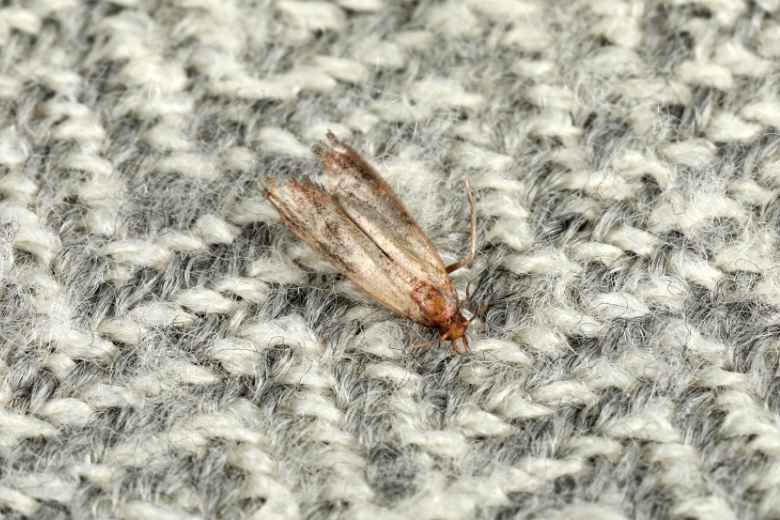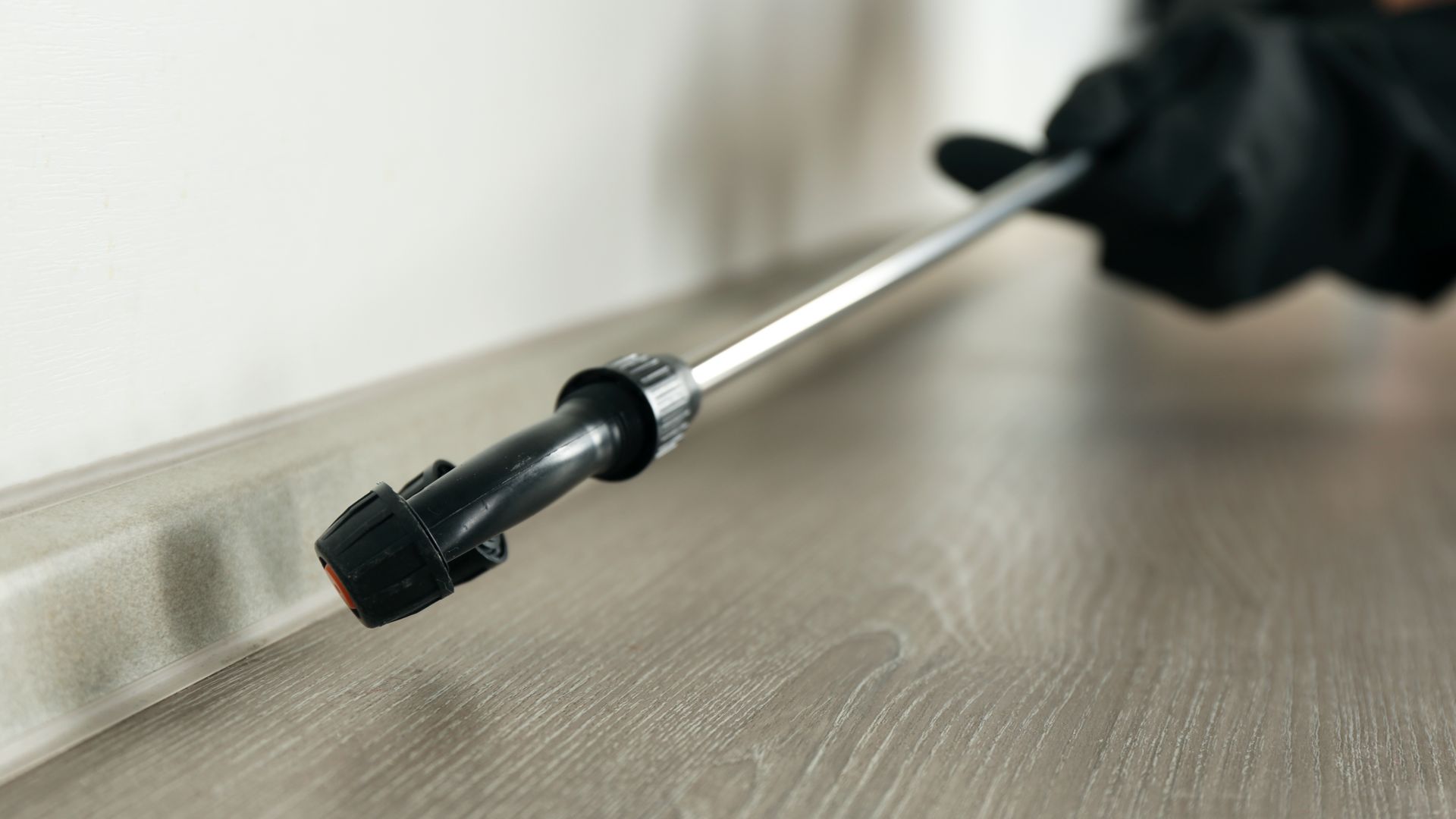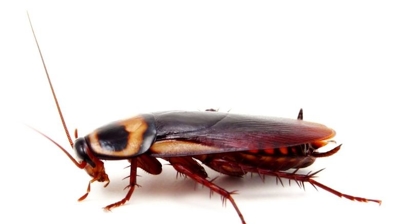
Clothes Moth Control Services

Clothes Moths
Clothes moths, particularly webbing clothes moths (Tineola bisselliella) and case-bearing clothes moths (Tinea pellionella), are considered harmful primarily because of the damage these moths cause to textiles and stored fabrics, rather than direct health effects:
Damage to Clothing and Fabrics
- Larval feeding: The larvae, not the adult moths, are the destructive stage. They feed on keratin-rich materials, such as wool, fur, silk, feathers, felt, down, and some leather items.
- Visible signs: Irregular holes, frayed fibers, or thin patches in clothing, upholstery, carpets, and blankets.
- Financial impact: High-quality wool, furs, and vintage textiles can be significantly damaged or ruined, leading to costly replacements.
Damage to Household Items
- Stored fabrics: Clothes moth larvae can infest storage boxes, garment bags, and attics, damaging items long before they’re used.
- Upholstery and carpets: Larvae can feed on wool carpets, rugs, and furniture upholstery, creating structural damage over time.
- Historical or sentimental items: Heirloom clothing, museum textiles, and antique rugs are particularly vulnerable and difficult to restore after infestation.
Contamination
- Larval silk and frass: Larvae leave behind silk webbing, fecal pellets, and casings, which can soil clothing and create an unclean appearance.
- Odor: Heavy infestations may produce a musty smell due to accumulated frass and silk.
Indirect Consequences
- Pest attraction: Infestations can attract other pests, such as carpet beetles, which may also feed on similar materials.
- Increased maintenance costs: Constant monitoring and cleaning can add significant expense and effort for homeowners or businesses.
Clothes moths are harmful because they destroy valuable textiles, cause contamination and aesthetic damage, and can create ongoing maintenance challenges. The actual harm is mostly economic and material, rather than health-related.
Learn more: Do Clothes Moths Bite?
Clothes Moth Removal
Clothes moths are a significant problem because of the specific type of damage they cause and the long-term consequences if infestations are left untreated. Unlike many other insects, clothes moths don’t feed on food—they feed on natural fibers, primarily keratin, which is found in materials like wool, silk, fur, feathers, and even certain types of leather. This feeding behavior directly damages clothing, upholstery, carpets, and stored textiles, creating holes, thinning fabric, and irreparable weakening of fibers.
The larvae, not the adult moths, are the destructive stage. They can persist in hidden areas such as closets, drawers, attics, or storage boxes, quietly consuming valuable items over weeks or months. Once an infestation is established, it can spread quickly because adult moths lay numerous eggs, and larvae can move between fabrics or storage containers.
Beyond the physical damage, there’s a financial and emotional cost. High-quality or heirloom garments, carpets, and textiles can be ruined, and restoration is often impossible. Infestations can also reduce the resale value of clothing and furnishings and may create ongoing maintenance issues if not eradicated promptly.
Early and thorough eradication prevents long-term reinfestation. Moths can survive in small, hidden crevices, so even a partial infestation can re-establish itself. Using a combination of prevention, cleaning, storage management, and our professional treatments when necessary ensures both immediate protection and long-term preservation of valuable fabrics.
Learn more: How To Get Rid Of Clothes Moths
Clothes Moth Control
Hiring our professional pest control for clothes moths is highly recommended because clothes moth infestations are often hidden, difficult to eliminate completely, and require specialized knowledge and tools:
- Accurate Identification: Many infestations that may seem to be moths are often actually carpet beetles or other fabric pests, which require different treatments. Our professionals can accurately identify the species of clothes moth, which is essential because webbing clothes moths (Tineola bisselliella) and case-bearing clothes moths (Tinea pellionella) behave differently. Misidentification can lead to ineffective DIY treatments and continued damage.
- Detection of Hidden Infestations: Clothes moth larvae often feed inside closets, storage boxes, attics, or behind baseboards, where they are invisible to homeowners. Our professionals use UV light traps or pheromone traps, inspection of storage areas, clothing, and carpets, detection of larval cases, silk, and frass. Early detection prevents extensive damage to textiles before it becomes irreversible.
- Comprehensive Treatment: DIY methods (like freezing or vacuuming) are often incomplete, especially in large infestations. Our professionals can provide targeted insecticide applications safe for indoor use, and fumigation for severe or widespread infestations. Our treatments target both larvae and adults, which is critical because adult moths continue to reproduce.
- Prevention and Monitoring: Our professionals don’t just kill the current infestation; we implement measures to prevent recurrence, such as proper storage guidance (airtight containers, vacuum-sealed bags), routine inspections, and various types of traps for ongoing monitoring. This is especially important in businesses, museums, or homes with expensive textiles.
- Time and Cost Efficiency: Attempting DIY control often requires multiple treatments over weeks or months, with risk of repeated damage. Our professionals quickly contain infestations, minimize textile loss, and reduce long-term costs compared to repeated home treatments or replacing damaged items.
- Safety: Proper chemical treatments require knowledge of toxicity, application methods, and ventilation. Our professionals ensure safe use of insecticides around fabrics, pets, and humans, and compliance with local regulations and safety standards.
Hiring our professional pest control ensures that clothes moth infestations are correctly identified, thoroughly treated, and prevented from returning. We save homeowners and businesses time, money, and textiles, while reducing the frustration and risk associated with DIY attempts.
Clothes Moth Exterminators
Hiring our local exterminators rather than a national company provides several tangible advantages when dealing with clothes moth infestations, especially because these moths are highly specialized and often require precise, targeted treatment. Here’s why our local professionals are the smarter choice:
- Local Expertise and Knowledge of Regional Infestations: Clothes moth activity can vary by region due to climate, humidity, and seasonal patterns. Our local exterminators are familiar with these conditions and understand which moth species are most common in the area, where they tend to hide, and how their infestations typically spread in local homes. This knowledge allows for more accurate inspection and tailored treatment plans rather than just generic solutions.
- Personalized Inspection and Treatment Plans: Our local exterminators conduct a detailed, in-person inspection of your home. Clothes moth larvae often hide in cracks, behind baseboards, inside closets, or even within stored boxes. National companies typically rely on standardized protocols and often overlook these subtle hiding places. Our local experts create customized solutions based on your home’s layout, the severity of the infestation, and the types of fabrics affected.
- Faster Response Times: Clothes moth infestations can escalate quickly, especially if larvae are already feeding on textiles. Our local exterminators can usually respond faster than a national company, arriving promptly for inspections and treatments. Our quick intervention is critical to prevent permanent damage to valuable clothing, rugs, and furnishings.
- Ongoing Support and Follow-Up: Our local team is more invested in maintaining a strong reputation within our community. This translates to thorough follow-up inspections, guidance on preventive measures, and ongoing support if moths reappear. National companies do not offer the same level of personalized service, and follow-up often involves delays or even additional fees.
- Knowledge of Safe, Targeted Treatments: Some national companies use broad chemical applications that are unnecessary for clothes moths, potentially affecting household items or fabrics. Our local professionals rely on targeted techniques, such as localized sprays, freezing, vacuuming, or pheromone traps, that are safer for sensitive textiles while still being highly effective.
- Cost Efficiency: Our local exterminators have lower overhead than national chains, meaning you typically pay less for inspection, treatment, and follow-up. At the same time, the treatment is often more effective, which reduces the risk of repeat visits or continuing damage—saving money in the long run.
Our local exterminators brings precision, responsiveness, and customized care, which are critical for a pest like clothes moths that quietly destroy fabrics over time. National companies cannot match the detailed, fabric-specific approach that protects your investment in clothing and textiles.
What Do Clothes Moths Look Like?
Clothes moths are small, inconspicuous moths that most people only notice when damage appears on fabrics. Their appearance varies slightly depending on the species, but here’s what the two most common types look like:
Webbing Clothes Moth (Tineola bisselliella)
- Size: 6–8 mm long (roughly the size of a small grain of rice)
- Color: Golden or straw-colored wings; shiny, uniform appearance
- Wing shape: Narrow, fringed edges; wings are folded over the body when at rest
- Other features: Tiny, tufted hairs on the head; adults are weak fliers
- Behavior: Usually avoid light and remain hidden in dark, undisturbed areas like closets or storage boxes
Case-Bearing Clothes Moth (Tinea pellionella)
- Size: Slightly smaller than webbing clothes moths, around 6–7 mm long
- Color: Light brown or tan wings with darker spots or speckles
- Wing shape: Narrow wings, also fringed, held roof-like over the body when at rest
- Other features: Larvae create portable silk cases they live in and carry around while feeding
- Behavior: Larvae feed hidden inside their silk cases, often attached to fabrics
Larvae (The Most Damaging Stage)
- Color: Creamy white or off-white with a brown head capsule
- Size: 1–12 mm depending on age
- Appearance: Soft-bodied, often with visible segments; sometimes seen with a silk web or case
- Damage: Larvae chew irregular holes in wool, silk, fur, and other keratin-rich materials
Key Identification Tips
- Adults are small, delicate, and avoid light; spotting them directly is rare
- Larvae and their silk cases, webbing, or frass are usually the first visible signs of infestation
- Damage is irregular holes or thinning areas in clothing or carpets rather than full-eaten sections
Where Are Clothes Moths Found?
Clothes moths are not outdoors pests in the usual sense—they prefer dark, undisturbed indoor environments where they can feed on natural fibers without disturbance. Here’s where you are most likely to find them:
Closets and Wardrobes
- Dark corners behind or under hanging clothes
- Especially where wool, silk, or fur garments are stored
- Areas with minimal movement or air circulation—moths avoid light and disturbance
Storage Areas
- Attics, basements, and storage boxes
- Unused suitcases or trunks containing natural-fiber clothing
- Fabric stored in cardboard boxes rather than sealed plastic containers
Furniture and Carpets
- Wool carpets, rugs, or upholstered furniture
- Under cushions, along edges, and under heavy furniture that is rarely moved
- Areas with dust or lint accumulation, as larvae often feed on these materials
Other Fabric Items
- Blankets, quilts, or down comforters
- Fur coats or hats
- Textile wall hangings or tapestries
Hidden or Overlooked Locations
- Cracks and crevices in baseboards or behind moldings
- Inside old pillows or stuffed toys made of natural fibers
- Dark corners behind bookshelves or rarely accessed cabinets
Key Factors That Attract Clothes Moths
- Natural fibers (keratin-rich materials) like wool, silk, fur, and feathers
- Dark, warm, and undisturbed areas
- Dust, lint, and animal hair, which provide additional food for larvae
Clothes moths rarely infest synthetic fabrics, and their adults avoid light, so infestations often go unnoticed until larvae damage is visible.
What Do Clothes Moths Eat?
Clothes moths primarily feed on natural fibers that contain keratin, a protein found in animal-derived materials. It’s the larval stage, not the adult moths, that does the actual feeding and causes damage:
Preferred Food Sources
- Wool – coats, sweaters, scarves, blankets, and rugs
- Silk – dresses, ties, and delicate garments
- Fur – coats, hats, and fur trims
- Feathers and down – pillows, comforters, and bedding
- Hair and animal fibers – including pet hair or hair found in textiles
Secondary Food Sources
- Dust and lint – often mixed with shed human or animal hair
- Stains containing protein – such as sweat, blood, food spills, or oils on clothing
- Occasionally plant fibers – if heavily soiled or blended with wool or silk
What They Do Not Eat
- Synthetic fibers like polyester, nylon, or acrylic (unless blended with natural fibers)
- Clean fabrics free of protein residues are less attractive
Feeding Behavior
- Larvae spin silk tunnels or cases in which they live while feeding
- They chew irregular holes in fabrics, often starting in hidden areas like seams, collars, or under folds
- Infestations are usually slow-moving, but damage accumulates over months
Clothes moths are harmful because they target high-value textiles made from natural fibers, and even small infestations can ruin clothing, upholstery, or bedding if left untreated.
Clothes Moth Life Cycle
Clothes moths have a complete metamorphosis life cycle consisting of four stages. Understanding each stage is essential for effective prevention and control:
Egg Stage
- Appearance: Tiny, oval, off-white eggs, about 0.5 mm in length
- Where laid: On natural-fiber materials such as wool, silk, fur, or feathers
- Quantity: Females can lay 40–50 eggs at a time, and up to 200–250 eggs in a lifetime
- Incubation period: 4–10 days under warm conditions (longer in cooler environments)
Larval Stage (Most Destructive)
- Appearance: Creamy-white or off-white, soft-bodied caterpillar-like larvae with a brown head
- Size: 1–12 mm depending on age
- Behavior: Larvae feed on keratin-containing fabrics and often spin silk webbing or cases for protection
- Duration: 1–6 months, but can extend up to 2 years in unfavorable conditions
- Damage: Chew irregular holes in clothing, carpets, upholstery, and other textiles
Pupal Stage
- Appearance: Encased in a silken cocoon attached to the feeding site or nearby hidden area
- Duration: 1–4 weeks, depending on temperature and humidity
- Function: Transformation stage where larvae become adults
- Note: Pupae are resistant to mild cleaning but vulnerable to heat or freezing
Adult Stage
- Appearance: Small, narrow-winged moths (golden or light brown, sometimes with spots)
- Feeding: Adults do not feed; their sole purpose is reproduction
- Lifespan: 2–4 weeks
- Reproduction: Females mate soon after emerging and lay eggs on nearby natural fibers
Reproductive Potential
- One female can produce up to 200+ eggs in her lifetime
- Multiple generations can occur per year in warm, undisturbed indoor environments
- Populations can explode quickly, especially in areas with abundant fabric or poor housekeeping
Clothes moths are most dangerous during the larval stage, which can last months and cause significant textile damage. Their high reproductive potential and ability to survive in hidden areas make infestations difficult to detect and eliminate without professional intervention.

Hear From Our Happy Customers
-
"Very Knowledgeable"
The tech that arrived was courteous, professional, and very knowledgeable. He was Great.
- Uerial I. -
"Exceeds Expectations"
I can’t say enough positive things about this company... The tech that came out, Jarvis went above and beyond my expectations. Thank you guys, I will continue using your services.
- Jake M. -
"Wonderful Service"
Wonderful service. Jarvis is great. Took care of everything I needed. Thank you!
- Henry P. -
"Great Communication"
Tech was on time, communication was great, and he accommodated my needs.
- Alonzo W. -
"Fantastic & Patient"
Jarvis was fantastic and patient. He answered my questions with an in-depth explanation and addressed all of my areas of concern. Would love for him to be my assigned tech going forward. Well done!
- Yonnette M. -
"Professional & Considerate"
I’m pleased with Miche services. Jarvis came today. Professional and considerate. Thank you!
- Judy B.



